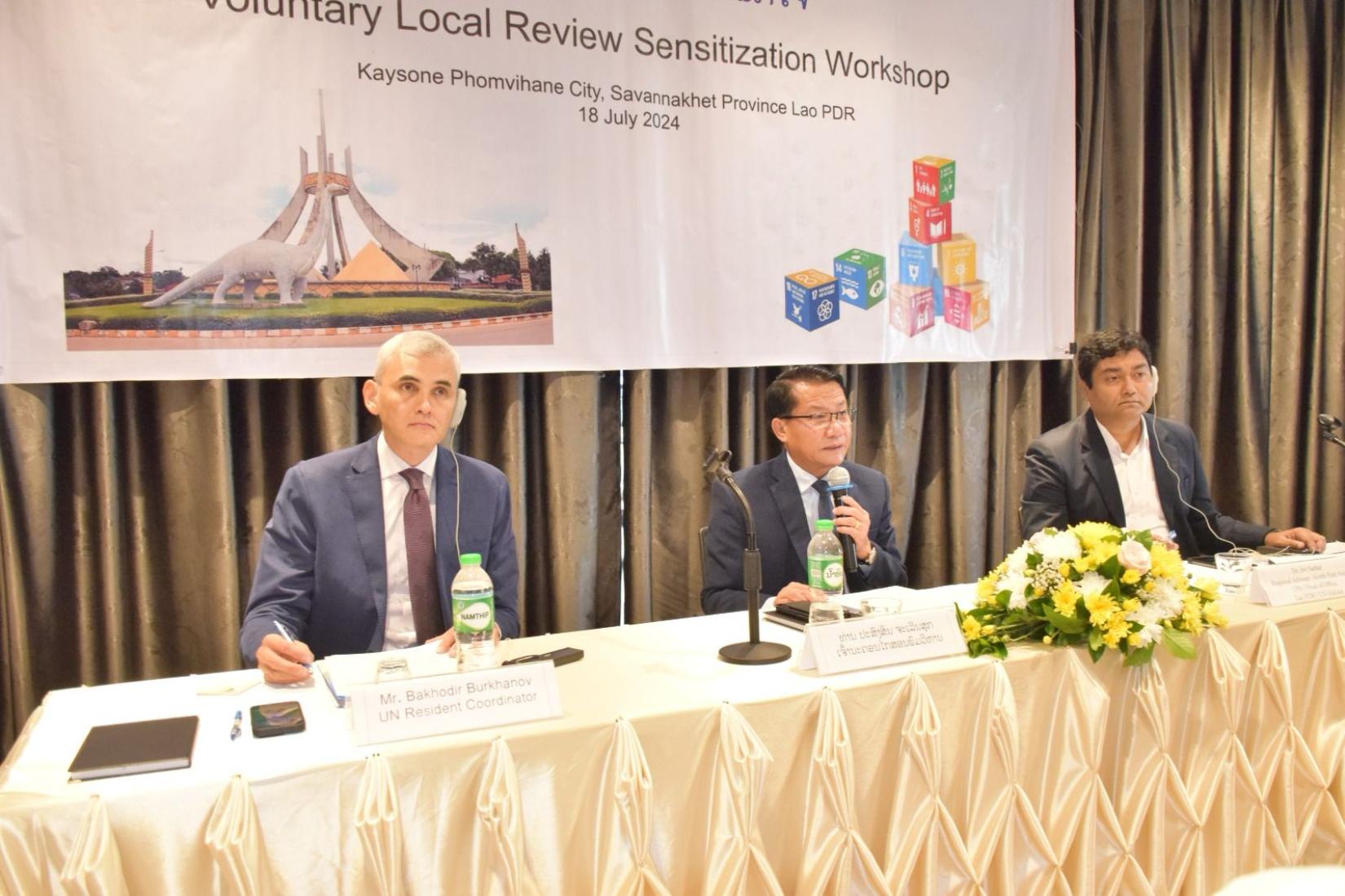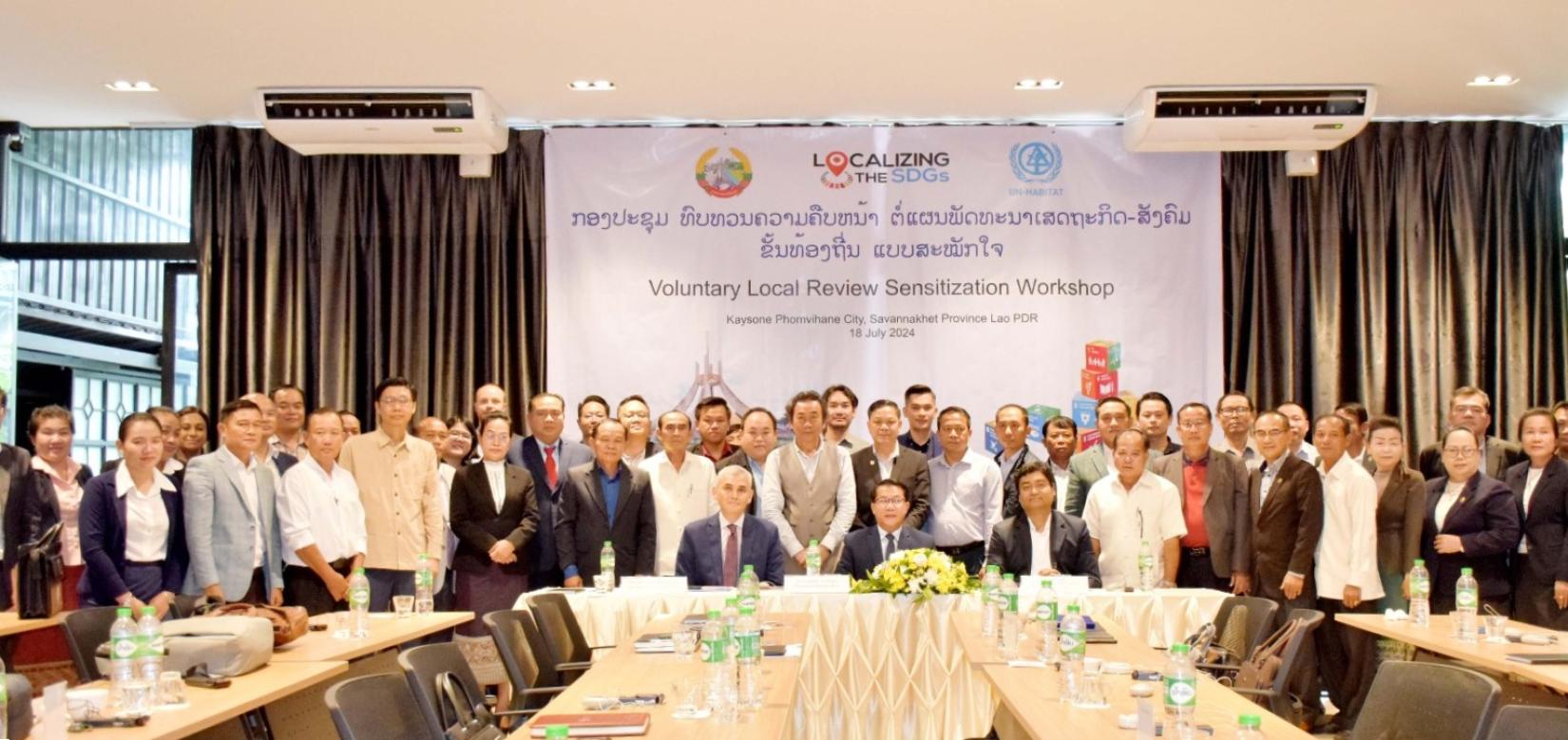Opening Remarks at Voluntary Local Review Sensitization Workshop
Remarks by Bakhodir Burkhanov, UN Resident Coordinator
Honourable Vice-Governor,
Honourable Mayor and representatives of Kaysone and Pakse cities,
Representatives of line Ministries,
Dear partners, colleagues, friends –
A good morning to all of you! It is a great pleasure to be here at the Voluntary Local Review Sensitization Workshop. I would like to take a moment to congratulate the co-organizers, UN-Habitat and Kaysone city.
The United Nations in Lao PDR is committed to strengthen SDG Localization in Lao PDR, and it is encouraging to see UN agencies starting to collaborate with provincial and local governments in this process.
I am grateful to UN-Habitat for spearheading this process of sensitization and knowledge-sharing in Lao PDR, as well as to other entities such as UN-ESCAP for being here today and paving the way for a coherent UN contribution to national SDG localization efforts.
I would like to acknowledge ministry counterparts, the Kaysone City Mayor and the team, for being here today and for the commitment toward the implementation of the 2030 Agenda for Sustainable Development.
A few weeks ago, the 2024 Sustainable Development Goals Report was launched, revealing that the world is significantly off-track to realize the 2030 Agenda, with only 17% of the SDGs globally on track. This is true for most Asia-Pacific countries, including Lao PDR, that are not on track to meet all the intended goals and targets.
At the national level, the Lao PDR government efforts are well recognized and the integration of the SDGs within its national planning framework, along with reporting as part of the Voluntary National Reviews, are clear signs of commitment toward the global goals.
In fact, just earlier this week, Lao PDR presented its 3rd Voluntary National Review Report (or VNR) at the High-Level Political Forum in New York. The report analyzes progress and status of all 17 SDGs and the National SDG 18 on Lives Safe from UXO. Coinciding with the mid-term review of the 9th National Socio-Economic Development Plan, it assesses national strategies, policies, plans and budgets to accelerate implementation of the achievement of the 2030 Agenda.
Today we are here to discuss a process to further boost the progress in implementing, monitoring and achieving the global goals – the SDG localization at the subnational levels. The localization is the process of transforming SDGs into reality at local levels, in coherence with the national frameworks, local plans and policies and in line with communities’ priorities.
It is estimated that more than 65% of the SDG targets are related to the work and mandate of local governments. Is therefore crucial to engage all levels of government and society to link local efforts and data to the national level.
Provincial and local governments in Lao PDR are already pursuing efforts at sustainable development, and directly or indirectly aligning their actions with the SDGs. The SDG localization serves to better frame these efforts in alignment with international standards and norms. One of the key tools of fostering SDG localization is the Voluntary Local Review (VLR).
VLRs help strengthen data environments at the local and national levels, foster participation, guide planning and budgets, and enhance multistakeholder coordination.
More than 300 VLRs have been published globally, led by local governments independently or with the support of UN and other partners, with a growing number in Asia-Pacific.
The VLRs are aligned with the 2030 Agenda and can be contextualized to the reality of countries. For instance, in Lao PDR they should serve to assess cities’ progress towards the National Socio-Economic Development Plan (NSEDP) goals and targets.
In addressing some of the key challenges that the 3rd VNR has identified, potential opportunities emerge:
- For instance, VLRs can enhance food systems by promoting sustainable farming techniques tailored to the specific needs of different regions within Lao PDR. Local governments can collaborate with farmers on community-based agricultural projects that improve food security and nutrition. This aligns with SDG 2 (Zero Hunger) and SDG 1 (No Poverty), addressing undernourishment and improving agricultural productivity.
- Further, local governments can drive renewable energy initiatives by developing community-level solar or hydropower projects. This can involve setting up small-scale solar power plants or promoting solar home systems in rural areas, supporting SDG 7 (Affordable and Clean Energy). Overcoming challenges such as limited access to electricity in rural/remote areas and high energy costs, as discussed in the VNR, can be more effectively managed through focused local projects.
- Or, implementing digital literacy programs and improving internet infrastructure in underserved areas can significantly enhance education and economic opportunities. Local governments can partner with the private sector to provide schools with affordable internet access and digital tools. This aligns with SDG 4 (Quality Education) and SDG 9 (Industry, Innovation, and Infrastructure), addressing the education and digital connectivity transitions, and tackling school dropout rates while improving digital infrastructure through focused local efforts.

Ladies and gentlemen –
It is clear that VLRs are more than a monitoring and reporting tools. The results of their assessments should provide data and evidence to inform the direction of local development plans and the prioritization of programs and projects.
Local governments are not expected to work alone. Only through collaborative and coordinated efforts across all levels and sectors of government, and with the involvement of other actors in the society, can we hope to achieve our common goals. In particular, the private sector, academia, civil society organizations and NGOs play a crucial role in development. Their representatives need to be recognized, consulted and included in the joined-up effort toward the achievement of the SDGs.
A lesson learnt from the 3rd VNR emphasizes the importance of engaging both local governments and communities so that no one is left behind. As we plan for a better future, the prosperity of our communities and those most vulnerable, should guide our efforts.
The VLR recognizes that local and provincial governments are closest to the reality of our communities. The UN stands ready to support them in their effort toward sustainable and inclusive development.
On behalf of the UN System, let me thank you for your commitment to the SDG localization in Lao PDR. I look forward to today’s discussion.


